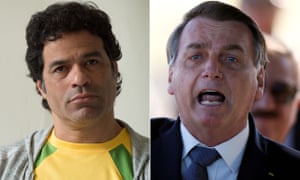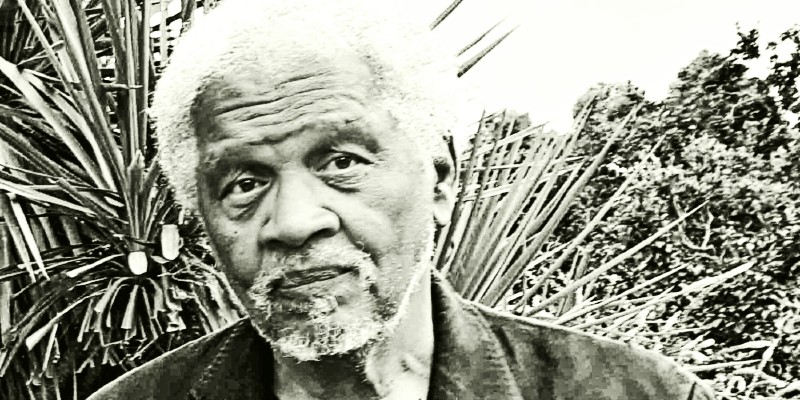Raí and Mauro Silva won the World Cup together in 1994. Now they are standing together to oppose the country’s president
By Tom Sanderson for Yellow & Green Football
Tom Sanderson
THE GUARDIAN
Wed 13 May 2020

São Paulo general manager Raí says Brazil president Jair Bolsonaro should resign. Composite: Getty Images
The coronavirus outbreak has yet not reached its peak in Brazil, but firebrand president Jair Bolsonaro – who caused outrage last month when he responded to news of increasing death tolls by saying “So what?” – is already attempting to rush the country’s footballers back to the field. “There are a lot of people in football who are favourable to a return because unemployment is knocking on clubs’ doors,” said Bolsonaro. “Footballers, if infected with the virus, have an infinitely small chance of dying. That’s because of their physical state, because they are athletes.”
Bolsonaro has been continually blasé about coronavirus, calling it a “little cold” exaggerated by media “hysteria”. During a failed attempt to get Brazilians to resume everyday life in late April, he told the nation that only old people are at risk. Bolsonaro is 65 years old but does not include himself in that group as he says he has the “history of an athlete”.
This bold claim opened him up to ridicule and prompted the resurfacing of a video taken last year in which Bolsonaro, a former military man who feeds off a supposed macho image, struggles comically through a set of press-ups. The video is particularly galling for Bolsonaro as it shows João Doria, the São Paulo state governor, performing the press-ups alongside him with ease. Doria was a Bolsonara ally during the campaign trail in 2018, but he is now a sworn enemy given his stricter views on lockdown restrictions.

air Bolsonaro says footballers in Brazil have ‘a small chance of dying’ from Covid-19
Bolsonaro is powerless to override the authority of individual states when it comes to isolation and, by sticking his nose in footballing matters, he has irked the director of football at one of Brazil’s biggest clubs. Raí, the legendary World Cup-winning midfielder who played for PSG in the 1990s and now runs São Paulo FC, criticised Bolsonaro for being “irresponsible” and flouting WHO guidelines. In a video interview with Globoesporte, Raí called for Bolsonaro’s resignation and blamed him for instigating “political crises” in the middle of a pandemic.
Bolsonaro has his supporters within the game. Caio Ribeiro, a former São Paulo and Brazil player who now works as a commentator, defended the president, saying he “didn’t like Raí’s speech” because he spoke “very little about sports and talked a lot about politics”. “He has to talk about sports,” said Ribeiro. “When he talks about resignation, public hospitals and all that, it seems to me that he has political connotations in relation to his preferences.”
Ribeiro’s suggestion that footballers and should stick to their primary field of expertise and not be outspoken on political matters sparked a debate, with Walter Casagrande – a highly respected pundit who played alongside Sócrates, Raí’s elder brother – defending the São Paulo director. “I think the exact same as Raí,” said Casagrande in an impassioned Instagram post. “I’m against the return of football at this moment. Every day the death toll rises in the country. It’s absurd to think about this.
“In a democracy, everyone can and should express their opinions, about every subject, independent of their profession. Nobody can wish to censor the speech of others and determine which subject they can talk about. Ultimately, Raí represented his brother Sócrates with pride and I have no doubt that he would say the same thing. People in football are pressed a lot for their lack of participation and opinion. Raí is one of the few who has taken a position. Congratulations, Raí!”

Luiz Felipe Scolari: 'Everything I did as a manager, I learned as a teacher'
Read more
Casagrande added that Raí would be a “a great companion in Democracia Corinthiana” – the movement led by his brother Sócrates in the mid-1980s that challenged the military dictatorship to which Bolsonaro and his supporters long to return.
Speaking exclusively to Yellow and Green Football, Raí responded to Ribeiro by saying: “Before anything in life, we are citizens. I am radically in favour of the free manifestation of ideas. Although I am not a controversial person, I am attentive to politics and social reality. When I perceive great injustices, ideological absurdities, or actions that can massacre the unfortunate [in society], indignation takes over and I manifest myself more strongly.”
Raí says he “doesn’t care” about the abuse he has received from Bolsonaro’s supporters and that he has “ignored them and the smell of their bigotry”. Regarding how his brother would feel about Bolsonaro’s behaviour and intentions, he agrees with Casagrande, saying Sócrates would “surely also be outraged and revolt – imagine Dr Sócrates! The way he would react!” Raí insists he will only consider allowing his club’s players to return to the pitch once the “health and sanitary authorities – the governor, mayor and secretary of health – have authorised it, preferably when the curve of deaths and number of infected citizens has been reversed”.

The Brazil team that won the World Cup in 1994, including Rai and Mauro Silva. Photograph: Colorsport/Rex/Shutterstock
Mauro Silva, who won the World Cup alongside Raí in 1994 and is now vice-president of the São Paulo state football federation, is backing his old teammate. Silva says the federation has decided “unanimously” that football should only return once the state authorities allow it. “The supreme federal court decided that states and municipalities have the autonomy to define isolation measures. So this is how we at the federation are working,” he said. He also offered his own personal support for Raí, saying: “Everyone has the right to speak out on whatever they want.”

Bruno Guimarães was ready to quit football. Now he is a Brazil player
Yet the government ploughs on with its hard-headed approach. The ministry of health – which is now being fronted by Nelson Teich after Luiz Henrique Mandetta was fired for opposing Bolsonaro’s lax views on coronavirus – sent a report to Brazil’s football federation in which they effectively concluded that football was too important to stay closed down. The ministry said they were “favourable” to a return as because they recognised that “football is a relevant sporting activity in the Brazilian context and that its resumption may contribute to measures to reduce social displacement through the transmission of games.”
Yet many in the game have reasons to disagree. Thirty-eight employees, including three players, have tested positive for coronavirus at the Série A champions Flamengo. Just like Brazil’s battle with the disease, the row between its leaders and those in the game has not yet reached its peak.
The coronavirus outbreak has yet not reached its peak in Brazil, but firebrand president Jair Bolsonaro – who caused outrage last month when he responded to news of increasing death tolls by saying “So what?” – is already attempting to rush the country’s footballers back to the field. “There are a lot of people in football who are favourable to a return because unemployment is knocking on clubs’ doors,” said Bolsonaro. “Footballers, if infected with the virus, have an infinitely small chance of dying. That’s because of their physical state, because they are athletes.”
Bolsonaro has been continually blasé about coronavirus, calling it a “little cold” exaggerated by media “hysteria”. During a failed attempt to get Brazilians to resume everyday life in late April, he told the nation that only old people are at risk. Bolsonaro is 65 years old but does not include himself in that group as he says he has the “history of an athlete”.
This bold claim opened him up to ridicule and prompted the resurfacing of a video taken last year in which Bolsonaro, a former military man who feeds off a supposed macho image, struggles comically through a set of press-ups. The video is particularly galling for Bolsonaro as it shows João Doria, the São Paulo state governor, performing the press-ups alongside him with ease. Doria was a Bolsonara ally during the campaign trail in 2018, but he is now a sworn enemy given his stricter views on lockdown restrictions.

air Bolsonaro says footballers in Brazil have ‘a small chance of dying’ from Covid-19
Bolsonaro is powerless to override the authority of individual states when it comes to isolation and, by sticking his nose in footballing matters, he has irked the director of football at one of Brazil’s biggest clubs. Raí, the legendary World Cup-winning midfielder who played for PSG in the 1990s and now runs São Paulo FC, criticised Bolsonaro for being “irresponsible” and flouting WHO guidelines. In a video interview with Globoesporte, Raí called for Bolsonaro’s resignation and blamed him for instigating “political crises” in the middle of a pandemic.
Bolsonaro has his supporters within the game. Caio Ribeiro, a former São Paulo and Brazil player who now works as a commentator, defended the president, saying he “didn’t like Raí’s speech” because he spoke “very little about sports and talked a lot about politics”. “He has to talk about sports,” said Ribeiro. “When he talks about resignation, public hospitals and all that, it seems to me that he has political connotations in relation to his preferences.”
Ribeiro’s suggestion that footballers and should stick to their primary field of expertise and not be outspoken on political matters sparked a debate, with Walter Casagrande – a highly respected pundit who played alongside Sócrates, Raí’s elder brother – defending the São Paulo director. “I think the exact same as Raí,” said Casagrande in an impassioned Instagram post. “I’m against the return of football at this moment. Every day the death toll rises in the country. It’s absurd to think about this.
“In a democracy, everyone can and should express their opinions, about every subject, independent of their profession. Nobody can wish to censor the speech of others and determine which subject they can talk about. Ultimately, Raí represented his brother Sócrates with pride and I have no doubt that he would say the same thing. People in football are pressed a lot for their lack of participation and opinion. Raí is one of the few who has taken a position. Congratulations, Raí!”

Luiz Felipe Scolari: 'Everything I did as a manager, I learned as a teacher'
Read more
Casagrande added that Raí would be a “a great companion in Democracia Corinthiana” – the movement led by his brother Sócrates in the mid-1980s that challenged the military dictatorship to which Bolsonaro and his supporters long to return.
Speaking exclusively to Yellow and Green Football, Raí responded to Ribeiro by saying: “Before anything in life, we are citizens. I am radically in favour of the free manifestation of ideas. Although I am not a controversial person, I am attentive to politics and social reality. When I perceive great injustices, ideological absurdities, or actions that can massacre the unfortunate [in society], indignation takes over and I manifest myself more strongly.”
Raí says he “doesn’t care” about the abuse he has received from Bolsonaro’s supporters and that he has “ignored them and the smell of their bigotry”. Regarding how his brother would feel about Bolsonaro’s behaviour and intentions, he agrees with Casagrande, saying Sócrates would “surely also be outraged and revolt – imagine Dr Sócrates! The way he would react!” Raí insists he will only consider allowing his club’s players to return to the pitch once the “health and sanitary authorities – the governor, mayor and secretary of health – have authorised it, preferably when the curve of deaths and number of infected citizens has been reversed”.

The Brazil team that won the World Cup in 1994, including Rai and Mauro Silva. Photograph: Colorsport/Rex/Shutterstock
Mauro Silva, who won the World Cup alongside Raí in 1994 and is now vice-president of the São Paulo state football federation, is backing his old teammate. Silva says the federation has decided “unanimously” that football should only return once the state authorities allow it. “The supreme federal court decided that states and municipalities have the autonomy to define isolation measures. So this is how we at the federation are working,” he said. He also offered his own personal support for Raí, saying: “Everyone has the right to speak out on whatever they want.”

Bruno Guimarães was ready to quit football. Now he is a Brazil player
Yet the government ploughs on with its hard-headed approach. The ministry of health – which is now being fronted by Nelson Teich after Luiz Henrique Mandetta was fired for opposing Bolsonaro’s lax views on coronavirus – sent a report to Brazil’s football federation in which they effectively concluded that football was too important to stay closed down. The ministry said they were “favourable” to a return as because they recognised that “football is a relevant sporting activity in the Brazilian context and that its resumption may contribute to measures to reduce social displacement through the transmission of games.”
Yet many in the game have reasons to disagree. Thirty-eight employees, including three players, have tested positive for coronavirus at the Série A champions Flamengo. Just like Brazil’s battle with the disease, the row between its leaders and those in the game has not yet reached its peak.







